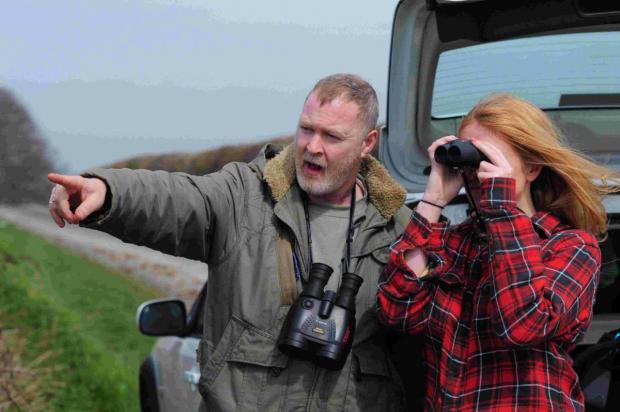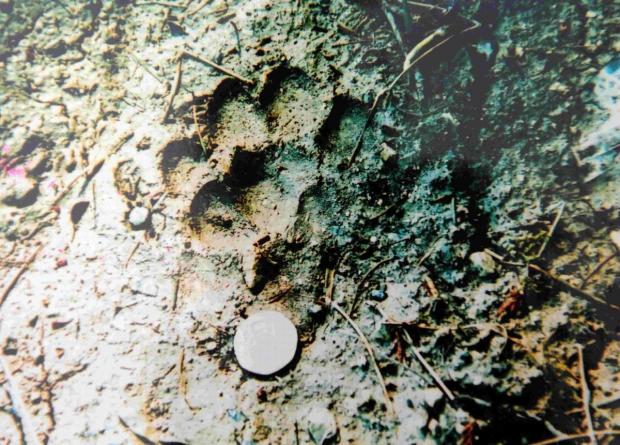Wednesday 16th October 2013
By Emma Walker

OUT THERE: Echo reporter Emma Walker and expert Jonathan McGowan. Left, scratching on a tree

PAWS FOR THOUGHT: Big footprints
Dorset Echo reporter Emma Walker joined the experienced naturalist in a search for evidence.
The hunt took place in fields off the A35 near Dorchester, where many sightings of a ‘big black cat’ have been reported to the Echo.
“We have had reports of black leopards, lynx, and pumas, which are light brown,” said Mr McGowan who says he saw his first puma while badger-watching in 1984.
The Dorset man has amassed a lot of ‘evidence’ in the last 30 years, including images of half-eaten deer, astonishing faeces, mystery fur and paw prints.
He said he was now working to collect even more to finally prove that the creatures exist in Britain.
This includes setting up expensive cameras across the county to capture footage and odd noises at night.
“Big cats have made their home in Dorset and across Britain – this is clear from the number of farm animals killed,” Mr McGowan said.
Large droppings have been found to contain deer and rabbit fur and animal bones.
The naturalist has uncovered dog remains up high in trees and paw-prints the size of a man’s hand that he claims are too large to belong to any other creature.
He claims to have already had positive test results which confirmed that he found leopard droppings in Dorset.
The expert told the Echo they would be the first to know about his future findings.
Big cats have roamed Britain for hundreds of years, according to Mr McGowan.
Before the Dangerous Wild Animals Act in 1976, the wealthy could take their lion, tiger or cheetah for a walk around the park without needing a licence.
But the law was changed to protect the public and animals.
While many owners gave their pets to zoos or put them down rumours started that some people released their animals into the wild where their offspring are thought to still roam to this day.
Mr McGowan claims big cats were brought to Britain by the Romans and have escaped from travelling zoos and menageries for decades.
He said: “The issue is confused now because they are hybrids – they have evolved.
“If you were to release just 10 leopards in the country they would find each other.
“They communicate using strong visual and olfactory signs.”
He stressed there was no danger to humans as big cats liked to remain undetected. The naturalist believes that the authorities try to cover up the presence of big cats in the country.
“The main problem is that it is a massive cover up because the authorities don’t want the public to panic.
“The other is trying to persuade the sceptics that the animals are actually there.”
Evidence for the mystery beasts
BIG Cat fur, mysterious droppings, territorial markings, paw prints and potential kills all surfaced on our search for a big cat, writes EMMA WALKER.
When I told people I would be trekking around rural Dorset looking for evidence of the mysterious creature they said I was mad.
But after doing my fair share of stories on the topic at the Echo, I was already pretty convinced that large cats exist in Britain.
And after my guide, wildlife expert Jonathan McGowan, told me everything I needed to know – the search began.
The most striking discoveries included some unusual animal fur on a barbed wire fence and several potential paw prints.
As the search continued, Jonathan said: “There may well be a big cat around here that is aware of our presence.
“They are extremely successful in avoiding detection.
“There are no other animals around here that could have left these traces and people need to know that big cats are a reality.”
According to the expert, the big cats sleep in hedgerows and furrow fares and eat anything from birds and berries to deer and cattle.
At the end of our search, Jonathan said it had been one of his most successful in recent weeks.
The wildlife expert has scoured the county for evidence of big cats and has amassed so much evidence that a hardened sceptic would find hard to ignore.
MEMBERS of the public play an important role in the big cat mystery, says naturalist Jonathan McGowan.
The dedicated wildlife expert has shared his tips on what signs to look for and is urging residents to contact him if they spot a mysterious creature.
He claims the best time to see a ‘big cat’ is at dusk or dawn in areas with a lot of deer or prey.
Tell-tale signs include:
Unusual fur caught on fences or barbed wire.
Mysterious droppings, known as ‘scats’, containing deer and rabbit fur, feathers and animal bones.
Clean animal kills including cattle and part-eaten deer on the ground or up in trees.
Territorial markings including scratch marks in trees and on the ground.
Anyone wishing to report a big cat sighting can email Mr McGowan at jrmczoo@tiscali.co.uk nARE big cats really on the prowl in Britain’s countryside?
Sightings of the creatures have been dubbed Britain’s most common encounter with the unknown, with more than 2,000 sightings now logged every year with the Big Cats in Britain Group.
According to figures obtained by the Echo last September, a total of 53 people have made emergency calls to report their wild cat encounters since 2006.
In those five years 22 calls were made by those who had dialled 999 to report having seen a ‘big cat’.
A total of 20 believers picked up the phone after claiming to see a ‘large cat’.
Eleven told officers they had seen a ‘black panther’ in the county.
Dorset-based big cat expert Merrily Harpur says she has received reports of more than 600 sightings in the last ten years.
source
No comments:
Post a Comment